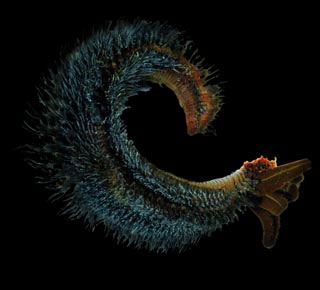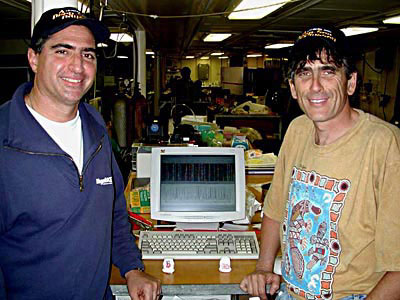Geotimes

Web
Extra
November 15, 2001
Biogeochemistry
Genetic
sequencing at sea
Last month, ocean scientists
put new biotechnologies to the test -- performing the first-ever DNA sequencing
at sea. Over the course of a 17-day research cruise aboard the research vessel
Atlantis, scientists sequenced just under 2 million base pairs of DNA
from different microbes and organisms that live in and around deep-sea hydrothermal
vents. "What we're trying to do is actually link the organism and its genetics
with the environment," says Craig Cary, a marine biologist at the University
of Delaware and the research team leader.
 Cary's
team conducted daily dives aboard the submersible Alvin into the waters
some 1,200 miles off the coast of Costa Rica to collect microbes, tubeworms,
vent crabs and other life forms that thrive in vent environments reaching temperatures
of 750 F. Of particular interest to their research is the Pompeii worm. Covering
the worm's back, Cary says, is a "fleece of bacteria." These microbes
may possess heat-stable enzymes useful in a variety of applications, such as
pharmaceutical production, food processing, paper and textile manufacture, and
hazardous waste cleanup. "The sequencing that we're doing and that will
be done continuously was really to understand how geochemistry is motivating
and moving the bacterial community," Cary says.
Cary's
team conducted daily dives aboard the submersible Alvin into the waters
some 1,200 miles off the coast of Costa Rica to collect microbes, tubeworms,
vent crabs and other life forms that thrive in vent environments reaching temperatures
of 750 F. Of particular interest to their research is the Pompeii worm. Covering
the worm's back, Cary says, is a "fleece of bacteria." These microbes
may possess heat-stable enzymes useful in a variety of applications, such as
pharmaceutical production, food processing, paper and textile manufacture, and
hazardous waste cleanup. "The sequencing that we're doing and that will
be done continuously was really to understand how geochemistry is motivating
and moving the bacterial community," Cary says.
[Previous University of Delaware research
confirmed that the Pompeii worm is the most heat-tolerant animal on Earth. Covering
this deep-sea worm's back is a fleece of bacteria. Courtesy of University
of Delaware College of Marine Studies.]
Previously, studying these
extreme, deep-sea environments proved difficult, because of time and technological
limitations in the field, Cary says. But now, with the MegaBACE 1000 DNA Analysis
System and the TempliPhi DNA Sequencing Template Amplification Kit from Amersham
Biosciences, they "were able to break a barrier that had always been in
place" to analyze the specimens' DNA as Alvin collected them and
brought them up to the surface.
Two scientists from Amersham
Biosciences conducted the DNA analysis using the company's sequencing systems,
the same technologies used in the Human Genome Project, but with some added
features to allow for the maritime application. "What was missing were
some of the steps in the laboratory to get the samples ready for sequencing,"
says Bob Feldman, production sequencing and collaborations manager at Amersham.
The application process, however, "shortens the whole process down to a
matter of only about a day, so that you can collect your organisms, make your
DNA and then basically just start sequencing right away. You don't have to spend
another three or four days and another three or four more pieces of equipment
to get things ready to go into sequencing," Feldman says.
 Both
Cary and Feldman say this kind of research is part of a new way of studying
creatures and their ecosystems in the field. Cary says he hopes to continue
the research with more field analyses next November. The National Science Foundation
funded the research. Although the expedition has ended, the expedition Web site
is still online at www.ocean.udel.edu/extreme2001.
Both
Cary and Feldman say this kind of research is part of a new way of studying
creatures and their ecosystems in the field. Cary says he hopes to continue
the research with more field analyses next November. The National Science Foundation
funded the research. Although the expedition has ended, the expedition Web site
is still online at www.ocean.udel.edu/extreme2001.
[Robert Feldman (left), of Amersham Biosciences,
and Craig Cary (right), University of Delaware marine
biologist and chief scientist for the Extreme 2001 expedition, in the lab on
board the R/V Atlantis.
Courtesy of University of Delaware College of Marine Studies.]
Lisa M. Pinsker
 Cary's
team conducted daily dives aboard the submersible Alvin into the waters
some 1,200 miles off the coast of Costa Rica to collect microbes, tubeworms,
vent crabs and other life forms that thrive in vent environments reaching temperatures
of 750 F. Of particular interest to their research is the Pompeii worm. Covering
the worm's back, Cary says, is a "fleece of bacteria." These microbes
may possess heat-stable enzymes useful in a variety of applications, such as
pharmaceutical production, food processing, paper and textile manufacture, and
hazardous waste cleanup. "The sequencing that we're doing and that will
be done continuously was really to understand how geochemistry is motivating
and moving the bacterial community," Cary says.
Cary's
team conducted daily dives aboard the submersible Alvin into the waters
some 1,200 miles off the coast of Costa Rica to collect microbes, tubeworms,
vent crabs and other life forms that thrive in vent environments reaching temperatures
of 750 F. Of particular interest to their research is the Pompeii worm. Covering
the worm's back, Cary says, is a "fleece of bacteria." These microbes
may possess heat-stable enzymes useful in a variety of applications, such as
pharmaceutical production, food processing, paper and textile manufacture, and
hazardous waste cleanup. "The sequencing that we're doing and that will
be done continuously was really to understand how geochemistry is motivating
and moving the bacterial community," Cary says.
 Both
Cary and Feldman say this kind of research is part of a new way of studying
creatures and their ecosystems in the field. Cary says he hopes to continue
the research with more field analyses next November. The National Science Foundation
funded the research. Although the expedition has ended, the expedition Web site
is still online at
Both
Cary and Feldman say this kind of research is part of a new way of studying
creatures and their ecosystems in the field. Cary says he hopes to continue
the research with more field analyses next November. The National Science Foundation
funded the research. Although the expedition has ended, the expedition Web site
is still online at 